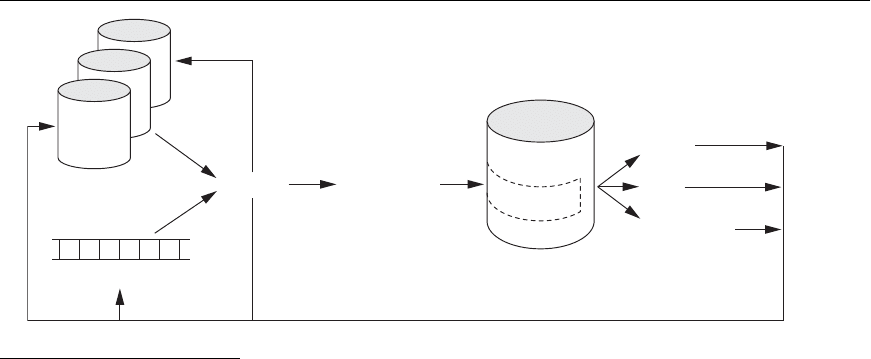Elmasri R., Navathe S.B. Fundamentals of Database Systems
Подождите немного. Документ загружается.


Table 28.1 Some Representative Data Mining Tools
Company Product Technique Platform Interface*
AcknoSoft Kate Decision trees,
Case-based reasoning
Windows UNIX
Microsoft Access
Angoss Knowledge
SEEKER
Decision trees, Statistics Windows ODBC
Business Objects Business Miner Neural nets, Machine learn-
ing
Windows ODBC
CrossZ QueryObject Statistical analysis,
Optimization algorithm
Windows MVS
UNIX
ODBC
Data Distilleries Data Surveyor Comprehensive; can
mix different types
of data mining
UNIX ODBC ODMG-
compliant
DBMiner
Technology Inc.
DBMiner OLAP analysis,
Associations,
Classification,
Clustering algorithms
Windows Microsoft 7.0
OLAP
IBM Intelligent Miner Classification,
Association rules,
Predictive models
UNIX (AIX) IBM DB2
Megaputer
Intelligence
PolyAnalyst Symbolic knowledge
acquisition, Evolutionary
programming
Windows OS/2 ODBC Oracle
DB2
NCR Management
Discovery Tool
(MDT)
Association rules Windows ODBC
Purple Insight MineSet Decision trees,
Association rules
UNIX (Irix) Oracle Sybase
Informix
SAS Enterprise Miner Decision trees,
Association rules, Neural
nets, Regression,
Clustering
UNIX (Solaris)
Windows
Macintosh
ODBC Oracle
AS/400
*ODBC: Open Data Base Connectivity
ODMG: Object Data Management Group
1062 Chapter 28 Data Mining Concepts
28.8 Summary
In this chapter we surveyed the important discipline of data mining, which uses
database technology to discover additional knowledge or patterns in the data. We
gave an illustrative example of knowledge discovery in databases, which has a wider
scope than data mining. For data mining, among the various techniques, we focused
on the details of association rule mining, classification, and clustering. We presented
algorithms in each of these areas and illustrated with examples of how those algo-
rithms work.
A variety of other techniques, including the AI-based neural networks and genetic
algorithms, were also briefly discussed. Active research is ongoing in data mining
and we have outlined some of the expected research directions. In the future data-
base technology products market, a great deal of data mining activity is expected.
We summarized 11 out of nearly one hundred data mining tools available; future
research is expected to extend the number and functionality significantly.
Review Questions
28.1. What are the different phases of the knowledge discovery from databases?
Describe a complete application scenario in which new knowledge may be
mined from an existing database of transactions.
28.2. What are the goals or tasks that data mining attempts to facilitate?
28.3. What are the five types of knowledge produced from data mining?
28.4. What are association rules as a type of knowledge? Give a definition of sup-
port and confidence and use them to define an association rule.
28.5. What is the downward closure property? How does it aid in developing an
efficient algorithm for finding association rules, that is, with regard to find-
ing large itemsets?
28.6. What was the motivating factor for the development of the FP-tree algo-
rithm for association rule mining?
28.7. Describe an association rule among hierarchies with an example.
28.8. What is a negative association rule in the context of the hierarchy in Figure
28.3?
28.9. What are the difficulties of mining association rules from large databases?
28.10. What are classification rules and how are decision trees related to them?
28.11. What is entropy and how is it used in building decision trees?
28.12. How does clustering differ from classification?
28.13. Describe neural networks and genetic algorithms as techniques for data
mining. What are the main difficulties in using these techniques?
Review Questions 1063
1064 Chapter 28 Data Mining Concepts
Trans_id Items_purchased
101 milk, bread, eggs
102 milk, juice
103 juice, butter
104 milk, bread, eggs
105 coffee, eggs
106 coffee
107 coffee, juice
108 milk, bread, cookies, eggs
109 cookies, butter
110 milk, bread
RID Age City Gender Education Repeat_customer
101 20...30 NY F college YES
102 20...30 SF M graduate YES
103 31...40 NY F college YES
104 51...60 NY F college NO
105 31...40 LA M high school NO
106 41...50 NY F college YES
107 41...50 NY F graduate YES
108 20...30 LA M college YES
109 20...30 NY F high school NO
110 20...30 NY F college YES
Exercises
28.14. Apply the Apriori algorithm to the following data set.
The set of items is {milk, bread, cookies, eggs, butter, coffee, juice}. Use 0.2
for the minimum support value.
28.15. Show two rules that have a confidence of 0.7 or greater for an itemset con-
taining three items from Exercise 28.14.
28.16. For the Partition algorithm, prove that any frequent itemset in the database
must appear as a local frequent itemset in at least one partition.
28.17. Show the FP-tree that would be made for the data from Exercise 28.14.
28.18. Apply the FP-Growth algorithm to the FP-tree from Exercise 28.17 and show
the frequent itemsets.
28.19. Apply the classification algorithm to the following set of data records. The
class attribute is
Repeat_customer.
28.20. Consider the following set of two-dimensional records:
Selected Bibliography 1065
RID Dimension1 Dimension2
18 4
25 4
32 4
42 6
52 8
68 6
Also consider two different clustering schemes: (1) where Cluster
1
contains
records {1,2,3} and Cluster
2
contains records {4,5,6} and (2) where Cluster
1
contains records {1,6} and Cluster
2
contains records {2,3,4,5}. Which scheme
is better and why?
28.21. Use the k-Means algorithm to cluster the data from Exercise 28.20. We can
use a value of 3 for K and we can assume that the records with RIDs 1, 3, and
5 are used for the initial cluster centroids (means).
28.22. The k-Means algorithm uses a similarity metric of distance between a record
and a cluster centroid. If the attributes of the records are not quantitative but
categorical in nature, such as
Income_level with values {low, medium, high}
or
Married with values {Yes, No} or State_of_residence with values {Alabama,
Alaska, ..., Wyoming}, then the distance metric is not meaningful. Define a
more suitable similarity metric that can be used for clustering data records
that contain categorical data.
Selected Bibliography
Literature on data mining comes from several fields, including statistics, mathemat-
ical optimization, machine learning, and artificial intelligence. Chen et al. (1996)
give a good summary of the database perspective on data mining. The book by Han
and Kamber (2001) is an excellent text, describing in detail the different algorithms
and techniques used in the data mining area. Work at IBM Almaden research has
produced a large number of early concepts and algorithms as well as results from
some performance studies. Agrawal et al. (1993) report the first major study on
association rules. Their Apriori algorithm for market basket data in Agrawal and
Srikant (1994) is improved by using partitioning in Savasere et al. (1995); Toivonen
(1996) proposes sampling as a way to reduce the processing effort. Cheung et al.
(1996) extends the partitioning to distributed environments; Lin and Dunham
(1998) propose techniques to overcome problems with data skew. Agrawal et al.
(1993b) discuss the performance perspective on association rules. Mannila et al.
(1994), Park et al. (1995), and Amir et al. (1997) present additional efficient algo-
rithms related to association rules. Han et al. (2000) present the FP-tree algorithm
1066 Chapter 28 Data Mining Concepts
discussed in this chapter. Srikant and Agrawal(1995) proposes mining generalized
rules. Savasere et al. (1998) present the first approach to mining negative associa-
tions. Agrawal et al. (1996) describe the Quest system at IBM. Sarawagi et al. (1998)
describe an implementation where association rules are integrated with a relational
database management system. Piatesky-Shapiro and Frawley (1992) have con-
tributed papers from a wide range of topics related to knowledge discovery. Zhang
et al. (1996) present the BIRCH algorithm for clustering large databases.
Information about decision tree learning and the classification algorithm presented
in this chapter can be found in Mitchell (1997).
Adriaans and Zantinge (1996), Fayyad et al. (1997), and Weiss and Indurkhya
(1998) are books devoted to the different aspects of data mining and its use in pre-
diction. The idea of genetic algorithms was proposed by Holland (1975); a good
survey of genetic algorithms appears in Srinivas and Patnaik (1994). Neural net-
works have a vast literature; a comprehensive introduction is available in Lippman
(1987).
Tan et al. (2006) provides a comprehensive introduction to data mining and has a
detailed set of references. Readers are also advised to consult proceedings of two
prominent annual conferences in data mining: the Knowledge Discovery and Data
Mining Conference (KDD), which has been running since 1995, and the SIAM
International Conference on Data Mining (SDM), which has been running since
2001. Links to past conferences may be found at http://dblp.uni-trier.de.

1067
Overview of Data
Warehousing and OLAP
T
he increasing processing power and sophistication
of analytical tools and techniques have resulted in
the development of what are known as data warehouses. These data warehouses
provide storage, functionality, and responsiveness to queries beyond the capabilities
of transaction-oriented databases. Accompanying this ever-increasing power is a
great demand to improve the data access performance of databases. As we have seen
throughout this book, traditional databases balance the requirement of data access
with the need to ensure data integrity. In modern organizations, users of data are
often completely removed from the data sources. Many people only need read-
access to data, but still need fast access to a larger volume of data than can conve-
niently be downloaded to the desktop. Often such data comes from multiple
databases. Because many of the analyses performed are recurrent and predictable,
software vendors and systems support staff are designing systems to support these
functions. Presently there is a great need to provide decision makers from middle
management upward with information at the correct level of detail to support deci-
sion making. Data warehousing, online analytical processing (OLAP), and data min-
ing provide this functionality. We gave an introduction to data mining techniques in
Chapter 28. In this chapter we give a broad overview of data warehousing and
OLAP technologies.
29.1 Introduction, Definitions, and Terminology
In Chapter 1 we defined a database as a collection of related data and a database sys-
tem as a database and database software together. A data warehouse is also a collec-
tion of information as well as a supporting system. However, a clear distinction
29
chapter 29

1068 Chapter 29 Overview of Data Warehousing and OLAP
exists. Traditional databases are transactional (relational, object-oriented, network,
or hierarchical). Data warehouses have the distinguishing characteristic that they are
mainly intended for decision-support applications. They are optimized for data
retrieval, not routine transaction processing.
Because data warehouses have been developed in numerous organizations to meet
particular needs, there is no single, canonical definition of the term data warehouse.
Professional magazine articles and books in the popular press have elaborated on
the meaning in a variety of ways. Vendors have capitalized on the popularity of the
term to help market a variety of related products, and consultants have provided a
large variety of services, all under the data warehousing banner. However, data
warehouses are quite distinct from traditional databases in their structure, func-
tioning, performance, and purpose.
W. H. Inmon
1
characterized a data warehouse as a subject-oriented, integrated, non-
volatile, time-variant collection of data in support of management’s decisions. Data
warehouses provide access to data for complex analysis, knowledge discovery, and
decision making. They support high-performance demands on an organization’s
data and information. Several types of applications—OLAP, DSS, and data mining
applications—are supported. We define each of these next.
OLAP (online analytical processing) is a term used to describe the analysis of com-
plex data from the data warehouse. In the hands of skilled knowledge workers,
OLAP tools use distributed computing capabilities for analyses that require more
storage and processing power than can be economically and efficiently located on
an individual desktop.
DSS (decision-support systems), also known as EIS—executive information sys-
tems; not to be confused with enterprise integration systems—support an organiza-
tion’s leading decision makers with higher-level data for complex and important
decisions. Data mining (which we discussed in Chapter 28) is used for knowledge
discovery, the process of searching data for unanticipated new knowledge.
Traditional databases support online transaction processing (OLTP), which
includes insertions, updates, and deletions, while also supporting information
query requirements. Traditional relational databases are optimized to process
queries that may touch a small part of the database and transactions that deal with
insertions or updates of a few tuples per relation to process. Thus, they cannot be
optimized for OLAP, DSS, or data mining. By contrast, data warehouses are
designed precisely to support efficient extraction, processing, and presentation for
analytic and decision-making purposes. In comparison to traditional databases,
data warehouses generally contain very large amounts of data from multiple sources
that may include databases from different data models and sometimes files acquired
from independent systems and platforms.
1
Inmon (1992) is credited with initially using the term warehouse. The latest edition of his work is Inmon
(2005).

29.2 Characteristics of Data Warehouses 1069
Databases Cleaning
Backflushing
Reformatting
Data mining
DSS
EIS
OLAP
Other data inputs
Updates/new data
Metadata
Data
Data warehouse
Figure 29.1
Sample transactions in
market-basket model.
29.2 Characteristics of Data Warehouses
To discuss data warehouses and distinguish them from transactional databases calls
for an appropriate data model. The multidimensional data model (explained in
more detail in Section 29.3) is a good fit for OLAP and decision-support technolo-
gies. In contrast to multidatabases, which provide access to disjoint and usually het-
erogeneous databases, a data warehouse is frequently a store of integrated data from
multiple sources, processed for storage in a multidimensional model. Unlike most
transactional databases, data warehouses typically support time-series and trend
analysis, both of which require more historical data than is generally maintained in
transactional databases.
Compared with transactional databases, data warehouses are nonvolatile. This
means that information in the data warehouse changes far less often and may be
regarded as non–real-time with periodic updating. In transactional systems, transac-
tions are the unit and are the agent of change to the database; by contrast, data ware-
house information is much more coarse-grained and is refreshed according to a
careful choice of refresh policy, usually incremental. Warehouse updates are handled
by the warehouse’s acquisition component that provides all required preprocessing.
We can also describe data warehousing more generally as a collection of decision sup-
port technologies, aimed at enabling the knowledge worker (executive, manager, ana-
lyst) to make better and faster decisions.
2
Figure 29.1 gives an overview of the
conceptual structure of a data warehouse. It shows the entire data warehousing
process, which includes possible cleaning and reformatting of data before loading it
into the warehouse. This process is handled by tools known as ETL (extraction,
transformation, and loading) tools. At the back end of the process, OLAP, data min-
ing, and DSS may generate new relevant information such as rules; this information
is shown in the figure going back into the warehouse. The figure also shows that
data sources may include files.
2
Chaudhuri and Dayal (1997) provide an excellent tutorial on the topic, with this as a starting definition.

1070 Chapter 29 Overview of Data Warehousing and OLAP
Data warehouses have the following distinctive characteristics:
3
■
Multidimensional conceptual view
■
Generic dimensionality
■
Unlimited dimensions and aggregation levels
■
Unrestricted cross-dimensional operations
■
Dynamic sparse matrix handling
■
Client-server architecture
■
Multiuser support
■
Accessibility
■
Transparency
■
Intuitive data manipulation
■
Consistent reporting performance
■
Flexible reporting
Because they encompass large volumes of data, data warehouses are generally an
order of magnitude (sometimes two orders of magnitude) larger than the source
databases. The sheer volume of data (likely to be in terabytes or even petabytes) is
an issue that has been dealt with through enterprise-wide data warehouses, virtual
data warehouses, and data marts:
■
Enterprise-wide data warehouses are huge projects requiring massive
investment of time and resources.
■
Virtual data warehouses provide views of operational databases that are
materialized for efficient access.
■
Data marts generally are targeted to a subset of the organization, such as a
department, and are more tightly focused.
29.3 Data Modeling for Data Warehouses
Multidimensional models take advantage of inherent relationships in data to popu-
late data in multidimensional matrices called data cubes. (These may be called
hypercubes if they have more than three dimensions.) For data that lends itself to
dimensional formatting, query performance in multidimensional matrices can be
much better than in the relational data model. Three examples of dimensions in a
corporate data warehouse are the corporation’s fiscal periods, products, and
regions.
A standard spreadsheet is a two-dimensional matrix. One example would be a
spreadsheet of regional sales by product for a particular time period. Products could
be shown as rows, with sales revenues for each region comprising the columns.
(Figure 29.2 shows this two-dimensional organization.) Adding a time dimension,
3
Codd and Salley (1993) coined the term OLAP and mentioned these characteristics. We have
reordered their original list.

29.3 Data Modeling for Data Warehouses 1071
Reg 1
P123
P124
P125
P126
Region
Product
Reg 2 Reg 3
Figure 29.2
A two-dimensional
matrix model.
such as an organization’s fiscal quarters, would produce a three-dimensional
matrix, which could be represented using a data cube.
Figure 29.3 shows a three-dimensional data cube that organizes product sales data by
fiscal quarters and sales regions. Each cell could contain data for a specific product,
P126
P127
Product
P125
P124
P123
R
e
g
1
R
e
g
2
R
e
gi
o
n
R
e
g
3
Qtr 1
Qtr 2
F
i
s
c
al
_q
u
a
rt
e
r
Qtr 3
Qtr 4
Figure 29.3
A three-dimensional
data cube model.
